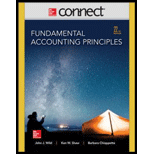
FUND.ACCT.PRIN -ONLINE ONLY >I<
22nd Edition
ISBN: 9780077632878
Author: Wild
Publisher: MCG
expand_more
expand_more
format_list_bulleted
Question
Chapter 8, Problem 10DQ
To determine
Introduction:
Cash Flow Statements:
- Cash flow statements are an integral part of the financial statements of a company. They reflect the direction and movement of the cash inflows and outflows during a reporting period. The cash inflows and outflows are segregated into the following activities:
Cash flows from Operating activities − The cash inflows refer to sales and income from operating activities and cash outflows include both cash and non-cash outflows from the operating activities i.e. the day to day activities of the business.
- Cash flows from Investing activities − The cash inflows refer to sales and income from investing activities and cash outflows include cash outflows from the investing activities in the form of purchase of fixed assets and investments.
- Cash flows from Financing activities − The cash inflows refer to income from financing activities such as raising share capital and debt and cash outflows include cash outflows from the financing activities in the form of dividends and interest paid.
There are two methods of preparing cash flow statements:
- Direct Method − It measures the actual cash inflows and cash outflows that are affected during a particular reporting period. The actual cash flows do not include non-cash items and items that are recorded owing to the accrual principle.
- Indirect Method −It measures the cash inflows and cash outflows that are affected during a particular reporting period including the non-cash items and items that are recorded owing to the accrual principle.
To Determine:
Cash flows from Investing Activities and Financing Activities for the year 2013.
Expert Solution & Answer
Want to see the full answer?
Check out a sample textbook solution
Students have asked these similar questions
General accounting
Calculate the return on assets.
Contribution margin ratio?
Chapter 8 Solutions
FUND.ACCT.PRIN -ONLINE ONLY >I<
Ch. 8 - Prob. 1DQCh. 8 - Prob. 2DQCh. 8 - Prob. 3DQCh. 8 - Prob. 4DQCh. 8 - Prob. 5DQCh. 8 - Prob. 6DQCh. 8 - Prob. 7DQCh. 8 - Prob. 8DQCh. 8 - Prob. 9DQCh. 8 - Prob. 10DQ
Ch. 8 - Prob. 11DQCh. 8 - Prob. 12DQCh. 8 - Prob. 13DQCh. 8 - Prob. 1QSCh. 8 - Prob. 2QSCh. 8 - Prob. 3QSCh. 8 - Prob. 4QSCh. 8 - Bank reconciliation P3 For each of the following...Ch. 8 - Prob. 6QSCh. 8 - Prob. 7QSCh. 8 - Prob. 8QSCh. 8 - Prob. 9AQSCh. 8 - Purchase discounts An important part of cash...Ch. 8 - International accounting and internal controls C1...Ch. 8 - Prob. 1ECh. 8 - Prob. 2ECh. 8 - Prob. 3ECh. 8 - Prob. 4ECh. 8 - Prob. 5ECh. 8 - Prob. 6ECh. 8 - Prob. 7ECh. 8 - Prob. 8ECh. 8 - Prob. 9ECh. 8 - Prob. 10ECh. 8 - Prob. 11ECh. 8 - Prob. 12ECh. 8 - Prob. 13AECh. 8 - Prob. 14BECh. 8 - Prob. 1APSACh. 8 - Prob. 2APSACh. 8 - Prob. 3APSACh. 8 - Prob. 4APSACh. 8 - Prob. 5APSACh. 8 - Prob. 1BPSBCh. 8 - Prob. 2BPSBCh. 8 - Prob. 3BPSBCh. 8 - Prob. 4BPSBCh. 8 - Prob. 5BPSBCh. 8 - Prob. 8SPCh. 8 - Prob. 1GLPCh. 8 - Prob. 1BTNCh. 8 - Prob. 2BTNCh. 8 - Prob. 3BTNCh. 8 - Prob. 4BBTNCh. 8 - Prob. 5BTNCh. 8 - Prob. 6BTNCh. 8 - Prob. 7BTNCh. 8 - Prob. 8BTNCh. 8 - Prob. 9BTN
Knowledge Booster
Similar questions
- What is the amount of fixed manufacturing overhead?arrow_forwardHow does reciprocal accounting differ?arrow_forwardZenith Ltd. operates in a highly competitive market. Market research shows the product can be sold for $80 per unit. Management wants to earn a 20% profit margin on sales. The current full cost to produce the product is $68 per unit. How much cost must Zenith cut per unit to meet the target profit margin? a. $12 b. $16 C. $4 d. $0arrow_forward
- Get correct answer this financial accounting question not use ai please don'tarrow_forwardneed helparrow_forwardD-Mart reported a net income of $19,500 for the previous year. At the beginning of the year, the company had $300,000 in assets. By the end of the year, assets had increased by $100,000. Calculate the return on assets.arrow_forward
arrow_back_ios
SEE MORE QUESTIONS
arrow_forward_ios
Recommended textbooks for you

 AccountingAccountingISBN:9781337272094Author:WARREN, Carl S., Reeve, James M., Duchac, Jonathan E.Publisher:Cengage Learning,
AccountingAccountingISBN:9781337272094Author:WARREN, Carl S., Reeve, James M., Duchac, Jonathan E.Publisher:Cengage Learning, Accounting Information SystemsAccountingISBN:9781337619202Author:Hall, James A.Publisher:Cengage Learning,
Accounting Information SystemsAccountingISBN:9781337619202Author:Hall, James A.Publisher:Cengage Learning, Horngren's Cost Accounting: A Managerial Emphasis...AccountingISBN:9780134475585Author:Srikant M. Datar, Madhav V. RajanPublisher:PEARSON
Horngren's Cost Accounting: A Managerial Emphasis...AccountingISBN:9780134475585Author:Srikant M. Datar, Madhav V. RajanPublisher:PEARSON Intermediate AccountingAccountingISBN:9781259722660Author:J. David Spiceland, Mark W. Nelson, Wayne M ThomasPublisher:McGraw-Hill Education
Intermediate AccountingAccountingISBN:9781259722660Author:J. David Spiceland, Mark W. Nelson, Wayne M ThomasPublisher:McGraw-Hill Education Financial and Managerial AccountingAccountingISBN:9781259726705Author:John J Wild, Ken W. Shaw, Barbara Chiappetta Fundamental Accounting PrinciplesPublisher:McGraw-Hill Education
Financial and Managerial AccountingAccountingISBN:9781259726705Author:John J Wild, Ken W. Shaw, Barbara Chiappetta Fundamental Accounting PrinciplesPublisher:McGraw-Hill Education


Accounting
Accounting
ISBN:9781337272094
Author:WARREN, Carl S., Reeve, James M., Duchac, Jonathan E.
Publisher:Cengage Learning,

Accounting Information Systems
Accounting
ISBN:9781337619202
Author:Hall, James A.
Publisher:Cengage Learning,

Horngren's Cost Accounting: A Managerial Emphasis...
Accounting
ISBN:9780134475585
Author:Srikant M. Datar, Madhav V. Rajan
Publisher:PEARSON

Intermediate Accounting
Accounting
ISBN:9781259722660
Author:J. David Spiceland, Mark W. Nelson, Wayne M Thomas
Publisher:McGraw-Hill Education

Financial and Managerial Accounting
Accounting
ISBN:9781259726705
Author:John J Wild, Ken W. Shaw, Barbara Chiappetta Fundamental Accounting Principles
Publisher:McGraw-Hill Education